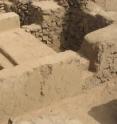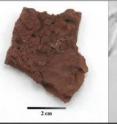Ancient humans left evidence from the party that ended 4,000 years ago
The party was over more than 4,000 years ago, but the remnants still remain in the gourds and squashes that served as dishware. For the first time, University of Missouri researchers have studied the residues from gourds and squash artifacts that date back to 2200 B.C. and recovered starch grains from manioc, potato, chili pepper, arrowroot and algarrobo. The starches provide clues about the foods consumed at feasts and document the earliest evidence of the consumption of algarrobo and arrowroot in Peru. "Archaeological starch grain research allows us to gain a better understanding of how ancient humans used plants, the types of food they ate, and how that food was prepared," said Neil Duncan, doctoral student of anthropology in the MU College of Arts and Science and lead author of the study that was published in the Proceedings of the National Academy of Sciences (PNAS) this week. "This is the first study to analyze residue from bottle gourd or squash artifacts. Squash and bottle gourds had a variety of uses 4,000 years ago, including being used as dishes, net floats and symbolic containers. Residue analysis can help determine the specific use."
In the study, researchers recovered starch grains from squash and gourd artifacts by a method that currently is used to recover microfossils from stone tools and ceramics. First, the artifact was placed in a special water bath to loosen and remove adhering residue. Then the artifact's interior surface was lightly brushed to remove any remaining residue. The residues were collected, and starch grains were isolated from each of these sediments.
"The starch residues of edible plants found on the artifacts and the special archaeological context from which these artifacts were recovered suggest that the artifacts were used in a ritual setting for the serving and production of food," Duncan said. "The method used in this study could be used in other areas and time periods in which gourds and squash rinds are preserved."
Scientists believe the Buena Vista site, where the starch grains were recovered, served as a small ceremonial center in the central Chillon Valley. The social and ritual use of food is not well understood during this time period in Peru, but this research will enhance the potential for understanding, Duncan said.
Source: University of Missouri-Columbia
Other sources
- Ancient Humans Left Evidence From The Party That Ended 4,000 Years Agofrom Science DailyWed, 22 Jul 2009, 3:14:18 UTC
- Ancient humans left evidence from the party that ended 4,000 years agofrom Science BlogTue, 21 Jul 2009, 18:42:11 UTC
- Ancient Humans Left Evidence from the Party that Ended 4,000 Years Agofrom PhysorgTue, 21 Jul 2009, 17:35:23 UTC

